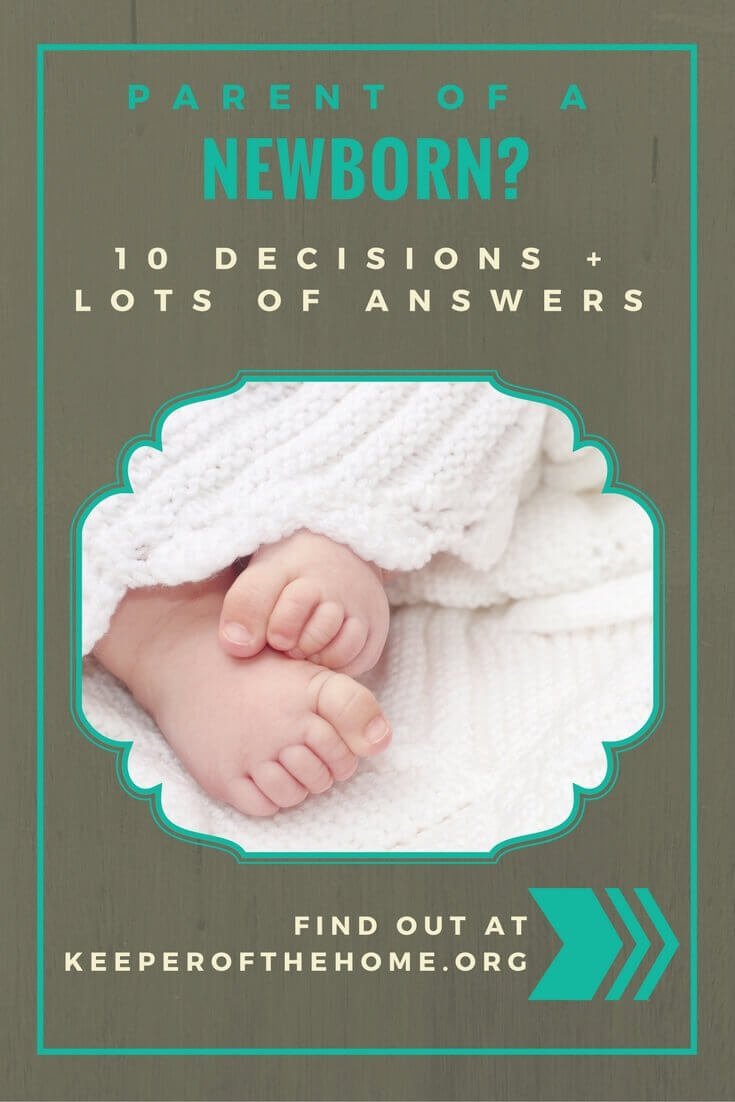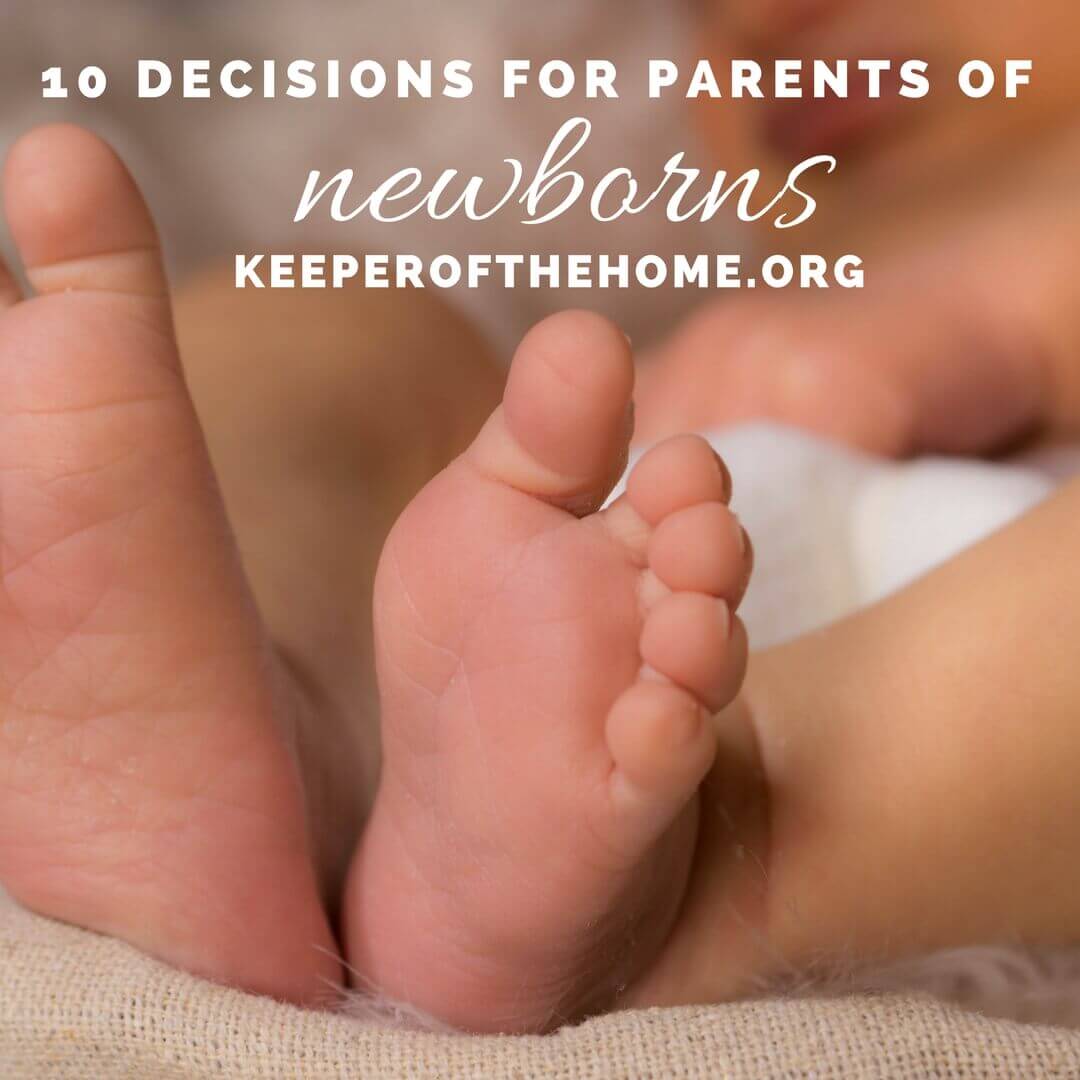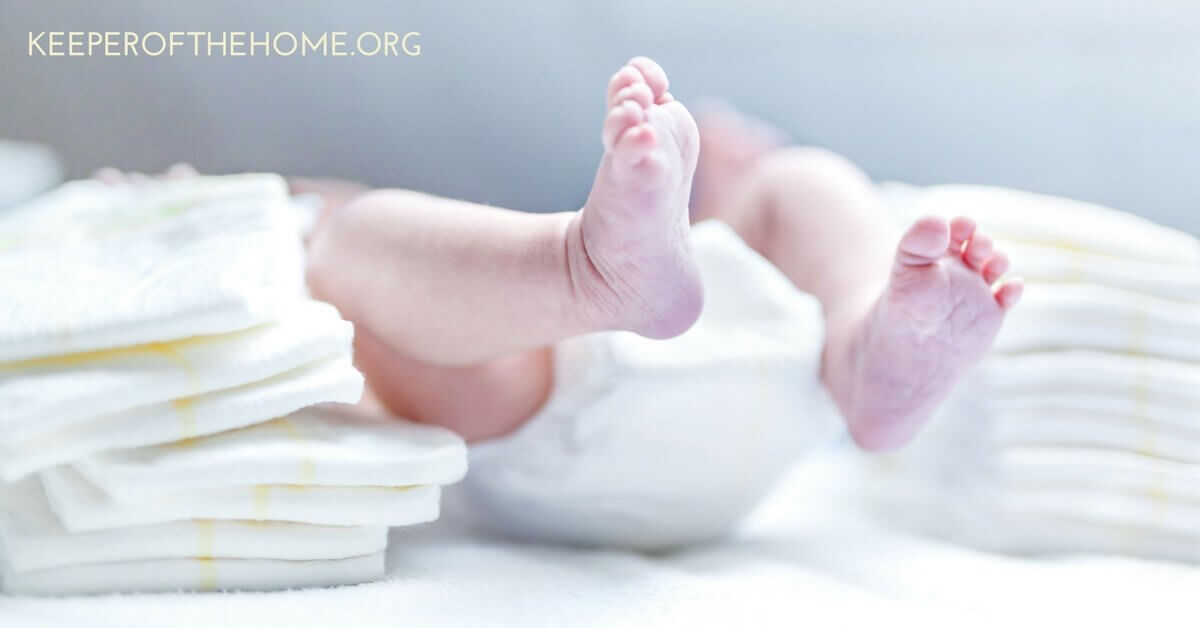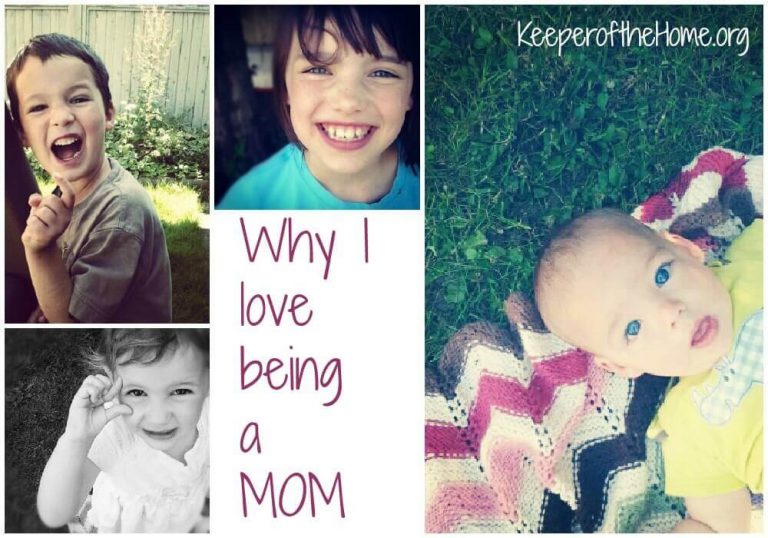10 Decisions for Parents of Newborns
If you’re a new mom, chances are you’ve heard countless people tell you what you should do with your pregnant self and with your newborn when he/she arrives into the world. Am I right?
At Keeper of the Home, we believe you should have every opportunity to make the best decision possible for you and your baby. This post sheds light on some of the tough choices parents will face.
This is not an argumentative piece but rather informative to help you on your journey. As a new mom at 21-years-old, I remember how heart-wrenching some of these topics seemed at the time.
While I didn’t make all of the same decisions that Christina did, I think the information she has provided is helpful to new parents learning to navigate the rough and joyous waters of caring for another’s life.
Getting to the birth of your child took a dozen medical decisions at least, some small, some large. Well, your baby’s been born, you’re recovering (or trying to), and the decisions just won’t let up. Welcome to parenthood! 🙂
Let’s walk through each of the 10 decisions you will probably be asked to make before leaving the hospital, birthing center, or at your child’s first pediatric visit (if you delivered at home). I’ll present each issue, ask the questions “Why would you want this?” “Why might you decline this?” and then offer several options.
Please note: We do our utmost to offer the best and most accurate information that we can, but we also encourage you to take the advice from our site as entertainment and informational purposes only and to always seek the advice of your trusted healthcare professional.

1. Cord Clamping
At some point between your child’s dramatic exit into the world and his first bath, you’re going to have to physically sever the link that kept him alive in your womb for so long: the umbilical cord. Many doctors or midwives don’t think twice about clamping and cutting it within the 2 minutes of birth, often sooner for a baby struggling to breathe. There is also the new pressure to collect your child’s “cord blood” stem cells, either for your family’s use or for donation to others.
-
Why might you want to cut the cord early?
Stem cells in umbilical cord blood carry the potential to treat several forms of cancer, blood, immune & metabolic disorders. To obtain enough blood to harvest these stem cells, the cord must be cut & clamped very soon after birth. If a family member has these diseases (and your child doesn’t) this is an option you may want to explore. This is from the AAP’s 2007 statement on the topic:
Cord blood donation should be discouraged when cord blood stored in a bank is to be directed for later personal or family use, because most conditions that might be helped by cord blood stem cells already exist in the infant’s cord blood (ie, premalignant changes in stem cells). […] Although not standard of care, directed cord blood banking should be encouraged when there is knowledge of a full sibling in the family with a medical condition (malignant or genetic) that could potentially benefit from cord blood transplantation. (emphasis mine)
-
Why might you want to wait?
Cord blood is actually the baby’s blood, usually about 1/3rd of the baby’s total blood volume– throughout pregnancy the baby’s blood is filtered through the placenta/umbilical cord and then pumped back into the baby. After birth, the blood is flowing back into the baby as long as the cord is pulsating (a safeguard in case the baby doesn’t breathe right away– the placenta is still oxygenating their blood for them).
Delaying the cord clamping 4-10 minutes, or until the umbilical cord stops pulsating, offers many benefits to the baby, while early cord clamping can be very harmful to the child- particularly if the baby has been born early or is on the small side.
As this article points out “delaying the cut could protect against anemia and irregular breathing for weeks and months after delivery.” Dr. Sarah Buckley outlines the risks of early cord clamping here.
Other parents opt for a “lotus birth,” never cutting the cord at all, but instead treating the placenta with salt, wrapping it in a bag and allowing the cord to dry up and fall off at the belly button on its own. Please note that all of these options ARE equally available for mothers delivering by cesarean (you just have to state your wishes).
-
Your options:
- Cut & clamp immediately for the purpose of cord blood harvesting/donation
- Delay the cord severing for 5 minutes
- Delay the cord severing until it stops pulsating (indicating that the vast majority of the baby’s blood is back in his body)
- Delay the severing until the placenta is delivered
- Allow the cord/placenta to fall off on its own in a matter of days
2. Washing, Weighing, Swaddling Immediately vs. Kangaroo Care
In many hospitals, the norm is to take the baby after birth over to a scale to be weighed, rubbed down, assessed using the APGAR scale at 1 & 5 minutes old, swaddled & hatted, and then returned to the mother.
However, this has lately been challenged and “kangaroo care” is the new buzzword. Many mothers are now encouraged to hold their babies skin-to-skin immediately after birth, covered with a clean blanket to keep them warm. The APGARs can be done in the mother’s arms, the baby can be rubbed clean & dry, and will usually attempt to breastfeed on his own soon after birth.
-
Why might you want the standard care?
If you require many stitches after birth (or any emergency measures), if you’ve had a particularly exhausting labor, or if a c-section means you are heavily medicated, you may not be physically able to keep a good hold on your child. In this case, the father or other family member could step in, often holding the baby at your head near your eye level, allowing the baby to see you and smell you.
-
Why might you want to opt out in favor of “kangaroo care”?
Many new moms don’t want to let their babies, the prize of their labor pain, go! I think I probably would have bit, scratched or punched anyone who tried to take my daughter from me that first hour after she was born! A 2007 pilot study indicated that babies placed skin-to-skin with their mothers held their body temperature better, and most “crawled” to their mother’s breast & began nursing on their own within 75 minutes of birth.
Most newborns are quietly alert and eager to nurse, learn their mother’s face, and bond with her for about 2 hours after birth, becoming sleepy (usually for the next 2 weeks) after this unique “sensitive window” is passed. Baby (and mom!) have just gone through tremendous changes and Mom’s familiar smell, heartbeat, and voice are tremendously comforting to this new little person who is suddenly being asked to breathe, maintain body heat, pump blood, eat, digest and poop on his own for the first time.
-
Your options:
Honestly, kangaroo care has so many benefits (and no drawbacks) that if you are unable to perform it yourself after birth, it would be recommended that your husband would hold the baby skin-to-skin on his chest, comforting and speaking to his baby until you are able to do so.
3. Prophylactic Eye Ointment
You’re probably familiar with the pictures of newborns in those striped hats, eyes smeared with some kind of clear goop. That “eye goop” is usually administered within 1 hour of all births, and is generally either erythromycin or tetracycline (both antibiotics), or the older silver nitrate solution.
-
Why might you want this?
The intention of the eye ointment is to prevent newborn blindness from infection after birth (“opthalmia neonatorum”). If the mother has gonorrhea, it can be passed on to the baby during a vaginal delivery and can cause blindness if left untreated (chlamydia is similar, as well as herpes). To avoid this, states passed laws throughout the 1900s mandating that all newborns receive silver nitrate, assuring that any infections would be caught and treated. This eye-irritant is still administered in some hospitals, but most now use the gentler antibiotics.
If you know that you have an STD and you deliver vaginally, you will want to protect your baby’s eyes. In this case, you can request the gentler tetracycline drops.
-
Why might you opt out of this?
For one, having a C-section negates the need for this completely. Anything placed in a baby’s eyes interferes with his vision, blurring it and usually causing swelling & irritation. Blurred vision interferes with the “sensitive window” right after birth when baby is alert & awake, so crucial in mother-child bonding as well as the establishment of breast-feeding.
Silver nitrate is only effective against gonorrheal infections, and is such an eye-irritant that it can actually cause chemical infections (read a good paper here). It has mostly been replaced by less-painful antibiotics, however these antibiotics carry their own risks. As this study showed, babies actually need the bacterial exposure they receive from their mother’s birth canal to correctly populate their digestive tracts and build up their immune systems:
“In a sense, the skin of newborn infants is like freshly tilled soil that is awaiting seeds for planting — in this case bacterial communities,” said Fierer of CU-Boulder’s ecology and evolutionary biology department. “The microbial communities that cluster on newborns essentially act as their first inoculation.”
Antibiotics upset the bacterial balance in our bodies, wherever they are administered (we’ve all heard about the dangers of over-using antibiotics). If a mother is known to be disease-free, there seems little reason to administer any ointment at all. A randomized 1993 trial in Washington State states
“The results suggest that parental choice of a prophylaxis agent including no prophylaxis is reasonable for women receiving prenatal care and who are screened for sexually transmitted diseases during pregnancy.” (emphasis mine)
-
Your options:
Be tested for STD infection in your 3rd trimester (this is state law anyway). If positive, find out if intravenous treatment can eliminate risk of transmission to the baby during birth, and/or choose the eye ointment best suited to your infection. If negative, you may delay administration of the eye drops until after the sensitive 2 hour period, choose the gentlest eye-ointment you can, or refuse the ointment completely.
(Note: in my state, Kentucky, hospitals are required by law to administer an ointment of some kind, and some try to threaten parents with Child Protective investigations, etc. However, when I made my own calls to various hospitals as well as our Child Safety office, I found that these were 100% intimidation tactics. Research the penalties and state laws in your own state) Have others wash their hands when touching your baby to minimize exposure to external bacteria.

4. Hepatitis B Vaccine
The CDC recommends that all infants receive the Hep B vaccine before leaving the hospital after birth, then receiving 2 more doses.
-
Why might you want the shot?
If you have hepatitis B, which is a serious infection of the liver, you probably want to do everything you can to avoid passing it on to your child, including a special hepatitis B immune globulin shot as well as the HepB vaccine.
-
Why might you want to opt out?
Unless you have hepatitis B, it is almost impossible for your child to contract it. It is a sexually transmitted disease (also transmitted through blood, as in needle sharing) for which babies are not at risk. The hepatitis B vaccine has many side effects, and newborns are extremely fragile. (Read ThinkTwice!’s info page here.) It makes little sense to submit a developing nervous and immune system not at risk of infection to such an attack.
- Your options:
If your child is not at risk for Hep B, you can delay the vaccine until later, or refuse it all together (it is not required for school entry in many states).
5. Hearing Test
For most babies, a hearing test is the first test they’ll ever have (and quite likely will pass with flying colors). All states require that parents at least be given the option of having their child’s hearing screened, and most have a policy of universal screening.
-
Why might I want this?
Hearing loss is one of the most common birth defects, affecting ~3 out of 1000 babies. The screens are non-invasive and inexpensive ($10-$50), and if hearing loss is caught and treated early, long-term consequences such as language delays can be minimized.
-
Why might I opt out?
You may want to simply observe your child for hearing loss on your own. In 14 states this is a simple matter of parental preference. During some types of tests babies may be given a mild sedative to which you may object. Also, some may be responsible for paying for the test and find the cost prohibitive.
-
Your options:
Have the test done after the “sensitive window,” when your baby is sleepy and unlikely to need a sedative– perhaps right after a good feeding. Or, if your child has no risk factors for hearing loss, opt out of the test and be especially vigilant for any signs of hearing deficiencies (this checklist is a helpful in this).
6. Newborn Heel Prick Metabolic Disorders Screen
Babies usually have a single heel prick to draw a drop or two of blood, which is put on filter paper and run through a tandem mass spectrometry test to screen for an average of 20+ inherited metabolic disorders, including PKU, cystic fibrosis and sickle-cell anemia. Some states recommend two such tests- one immediately after birth and one just before hospital dismissal.
-
Why might I want this?
Many see the trade off of a single heel prick for the screening of so many diseases –many both potentially fatal AND treatable– as quite worthwhile. If you know that any of the diseases tested for run in your family, this seems especially a wise choice. (However, different regions test for different diseases, so ask for a full list from your pediatrician or intended place of delivery.)
-
Why might I want to opt out?
All of the diseases screened for are very rare. The blood screen’s rate of false positives is relatively high. Thus many parents receive news their child needs further (more invasive) tests, may be advised to suspend breast-feeding in the meantime, and are understandably concerned, only to be told that the diagnosis was negative.
Additionally, some of the disorders have no treatment or cure, or have variations in forms which may require no intervention (despite showing up as “positive”). For these reasons, some doctors such as Dr. Robert Mendelsohn (in his book How to Raise a Healthy Child in Spite of Your Doctor) recommend waiting for signs of a disease before testing or testing specifically for a disease that runs in your family, and certainly asking for further information and testing if a screen comes back positive.
-
Your options:
Assent to the standard heel-prick screen as a precaution (see below for some steps to make it easier), test specifically for diseases for which your family has a history, or wait and see if any problems manifest, then pursue definitive testing. If one disease in the screen comes back with a positive result, know that many of these are false positives: continue breast-feeding, pursue further diagnostic testing, and try not to stress about it in the meantime.
**Please note that while the diseases are rare and the vast majority of kids will be fine with no screening, for the few that DO have a disease, an early detection often means the difference between life & death, or normal development & severe (often permanent) disability. For many metabolic diseases, which can appear with no family history, the symptoms are subtle and likely to be overlooked until potentially irreversible damage has been done.
With this in mind, here are 4 steps you can take to make the screen easier & more accurate for your baby, if you choose to assent to it:
- Wait to do the test, ideally 3 days after birth, so metabolic factors have stabilized
- Make sure baby is warm –especially warm baby’s foot in your hands for several minutes before prick to ensure that blood flows easily
- Request that nurse hold baby’s foot until she stops kicking and only then prick
- Offer baby something to suck during prick (finger, binky, bottle or breast)
7. Vitamin K Injection
Vitamin K is a fat-soluble vitamin we get chiefly from bacteria in our gut (it’s also in leafy green veggies). It is crucial in blood clotting & bone health. Babies are born with lower clotting factors than adults, perhaps because their intestines lack the bacteria which provide most of ours. A Vitamin K deficiency can lead to “vitamin K deficiency bleeding“– severe internal bleeding.
-
Why might I want this?
Bleeding in infants due to vitamin K deficiency can be severe, leading to hospitalizations, blood transfusions, brain damage and death. While formula is enriched with Vit K, breast-milk tends to be lower in it. Intra-muscular injection (i.e. a shot) of Vitamin K is quite effective in preventing internal bleeding.
There are several risk factors for VKDB, including: preterm delivery & difficulty feeding, low birth weight, delivery by forceps or vacuum extraction delivery, prenatal maternal use of certain medicines (including antibiotics, anticoagulants, & anticonvulsants), liver disease, extremely fast, or extremely prolonged labor, particularly during the pushing phase, and delivery by C-section.
-
Why might I want to opt out?
Many question whether God would design a faulty system– why would all babies be deficient in a vitamin that was also lacking in their natural food? Some feel that it’s preferable to instead supplement the breastfeeding mother’s diet with Vitamin K, both/either through a diet high in leafy greens and probiotics, or a supplement, rather than giving a newborn a painful injection.
Colostrum, which precedes milk, is quite high in Vitamin K. An injection is an unnatural means of getting a vitamin that is usually absorbed through the gut wall, and, like all injections, provides an opportunity for contamination to be introduced, as well as potentially toxic preservatives. The amount of Vitamin K injected is also very high: 20,000 times the level present at birth. Lastly, high Vitamin K levels are a cause of jaundice in newborns.
-
Your options:
Choose to have the injection as a precautionary measure, especially if your child had a traumatic birth, if your prenatal diet was low in Vitamin K, or if you took medications tending towards VKDB. Take a non-interventionist approach of a late-pregnancy diet high in leafy greens, delayed cord-clamping, and immediate breastfeeding. Or opt for the oral method of vitamin K supplementation.

8. Sleeping Arrangements
Many hospitals now offer the option of “rooming-in,” in which baby and mother are kept together in one room, as well as the former model of nursery care, in which babies are tended by nurses in a separate room. Few hospitals recommend that the baby stay in the nursery throughout the day, though it is always an option if you need a break. Fathers are usually welcome to accompany the baby into the nursery during any screens or tests (and if they aren’t, they can insist upon it!).
-
Why might you prefer the nursery model?
Many moms (and their spouses!) are exhausted after delivery and will be facing months of sleepless nights tending a newborn. The chance to have someone else changing diapers and keeping an eye out for problems can be a welcome and unique break, especially if you deliver at a hospital friendly to breast-feeding who will bring your baby to you to be fed at the first sign of hunger.
-
Why might you prefer to “room-in”?
Some new moms don’t want their precious children away from them at any point, especially if their hospital tends to force standard procedures (injections, eye ointment, etc.) on newborns despite parental preferences, or if they are likely to give a hungry baby a pacifier or a bottle of formula. As newborns have very little stomachs (large as a thimble), ounces of formula really sabotage their metabolism and eagerness to nurse (in turn interfering with maternal milk production). Entire nursing relationships have been sabotaged by bottles given before hospital discharge.
-
Your options:
Ask around and find out what hospital policy is regarding bringing babies to moms for feedings or giving them bottles– ask other patients and your doctor/midwife what this hospital’s reputation in this area is like. If it’s parental-preference friendly, you may want to take advantage of the nurses ability to watch over your child during the night (so you and Daddy can both sleep). If, however, the hospital nursery seems a risky place, keep baby with you, perhaps trading off with Daddy or another family member to tend to baby’s non-nutritive needs.
Note that you can begin one way and then switch as needed: I personally began with our daughter in our room, but when it became apparent that my husband & I were too tired after our 45-hour labor to adequately care for her, we gladly surrendered her to the nursery nurses, who faithfully brought her to me for feedings throughout the night and recorded her every diaper on her chart so I’d stay informed (Our hospital is stellar with respect to honoring parental wishes in all areas.).
9. Artificial Nipples (pacifiers or bottles)
Hospital nurses only have 2 arms, just like all of us, and tend to pacify crying babies with a pacifier rather than with cuddles. Some feel that sucking on a pacifier tires a baby out, decreasing their desire to eat. And some babies just plain old spit them out.
-
Why might you want to allow pacifiers?
Some babies like to suck. It’s a comfort thing– babies have been caught sucking fingers, thumbs, tongues, and hands in utero. As anyone who was a child-hood thumb-sucker knows, it’s hard to break those habits. Some parents would prefer that their baby’s “non-nutritive sucking” needs are met through a paci, which can be detached, washed, and eventually discarded instead of through a body part, which is always around (and often dirty).
-
Why might you want to avoid artificial nipples?
Some lactation experts warn of nipple confusion; with babies getting into poor latching habits after sucking on a paci or bottle (these require entirely different tongue positions). Many parents would prefer to allow their newborn to suck frequently at the breast, even if only for the first few days, to ensure a good milk supply, as well as to maximize skin-to-skin contact.
-
What are your options?
Allow pacifier use, limit it to times when baby isn’t hungry or your breasts are sore from a feeding, or request that no artificial nipples be used at all. If your baby is too weak to nurse or has a poor latch, you can still use systems other than a bottle ⏤ such as a supplemental nursing system (with expressed breast milk or formula), finger-feeding, or a dropper.
Here’s a handy trick: latches can usually be “reset” by simply allowing a baby to suck a finger, which gets the tongue in the correct position for breastfeeding.
10. Time of Discharge
Most hospitals keep mom and baby for 24-48 hours after an uncomplicated vaginal delivery. For moms with c-sections, 3 days is the minimum, and for complicated births moms & babies may be kept any number of days.
-
Why might you want to stay the full recommended 2 days?
State laws were passed in the mid-1990s regarding postpartum “Length of stays” (LOS) out of concern for maternal and infant health. Many health problems (such as a retained placental fragment, for instance) take a few days after birth to manifest themselves. Additionally, many mothers will not be going home to much help, so the rest and care they receive immediately after birth in the hospital can be very welcome.
-
Why might you want to ask for an early discharge?
Plainly put, even the best hospitals are dirty places ⏤ they’re mainly for sick, germy people. In this sense, getting a newborn and recovering mom out of there doesn’t seem a bad idea. Some mothers also find sleeping difficult in a hospital bed, and being woken by nurses every few hours for vitals to be checked can be wearing.
Some moms just recover faster in their own beds. Postpartum doulas ⏤ hired help specifically trained to care for newborns and their mamas ⏤ are far more available these days and can fill in the gap hospital nurses provide. Some midwives do house-calls, and many pediatricians or OBs will allow you to come in for a check-up 3 days post-partum, somewhat negating the need to spend all 48 hours under observation.
Studies in California after the LOS laws were passed showed “a significant decline in neonatal readmissions [to hospitals] but not in 1-year mortality.”
-
Your options:
Enjoy the full 2-day hospital stay, or ask for an early discharge if your delivery was uncomplicated and un-medicated, and follow up with a 3-day postpartum checkup for both mama and baby. Consider hiring a postpartum doula or having Grandma stay and care for you once home. You will likely need to get your OB/midwife and pediatrician to put a request for early discharge in writing, ideally in your birth plan.
For Parents of Little Boys: Circumcision
This is such a complicated issue (worthy of a post all its own) that I will only briefly touch on it. American doctors are split down the middle on recommending circumcision or not. The AAP’s official position states:
Existing scientific evidence demonstrates potential medical benefits of newborn male circumcision; however, these data are not sufficient to recommend routine neonatal circumcision. In circumstances in which there are potential benefits and risks,yet the procedure is not essential to the child’s current well-being,parents should determine what is in the best interest of the child.
Basically, it’s a preference issue. However, more boys are circumcised in the US than are not, often before leaving the hospital after birth.
-
Why might you want circumcision?
There do seem to be hygienic benefits to it: fewer yeast and urinary tract infections, lower cancer rates and drastically lower transmission rates of HIV, and STDs (even the female partners of circumcised men are slightly protected).
There is a small percentage of men who require circumcision later in life for medical reasons, and circumcisions later in life are far more complicated than in an infant. Babies don’t remember the pain of surgery. Many Christians feel that if God commanded it for generations, it likely has some health benefit to it, just as the dietary laws do. When performed by a mohel (Jewish rabbi specializing in circumcision) on the 8th day, the procedure is very quick (under a minute), usually done in the comfort of your home with your son held in familiar arms and anesthetized in non-invasive ways such as sugar pacifiers, drops of wine, and topical anesthetic cream.
-
Why might you want to skip this elective surgery?
The hygienic benefits of circumcision can usually be overcome through personal hygiene and a monogamous lifestyle later in life. It’s a painful surgery, even if some form of anesthetic is used. In hospitals, it is probably terrifying for the baby, who is separated from his parents, strapped down, and in considerable pain for 10-20 minutes.
As noted above, clotting factors are low in newborns and don’t rise until 5-7 days after birth, reaching their apex at 8 days after birth ⏤ surgery before then carries increased risk of hemorrhage. As some Christians have pointed out, modern hospital circumcision is quite different than the OT version in timing, method, and environment.
-
Your options:
Have the circumcision in the hospital before discharge (when it’s still covered by insurance), using one of the following methods decided on beforehand: the mogen clamp, the plastibell, or the Gomco clamp. Research each as well as the doctor who will perform the circumcision.
Alternatively, wait until the 8th day (as is Jewish custom due to Genesis 17:9-14) for the surgery at the hospital, or hire a mohel to perform the surgery in your home or the hospital, usually using the Jewish shield technique. Or, you can skip the surgery altogether and add extra emphasis to your son’s personal hygiene.
(As a mom making this decision myself, I must say that, should we choose to circumcise our son, of all the methods the mohel-performed, Jewish shield technique seems the quickest, least painful, traumatic, and risky; well worth the extra cost.)

Please remember that what we are sharing is the result of our own experiences and years of study, but may not necessarily be the right course of action for you. We are advocates of becoming informed, knowledgeable, and responsible for one’s own health, but our desire is not to be an authority on any matters of health for you, nor would we presume to have sufficient knowledge to do so. Our hope is that what we share may encourage you and start you on the road to doing your own research and seeking the opinions of professionals or others that you trust.







Your not told about these things in the hospital. This was very informative.
I wanted to print this to send to my daughter in law who is pregnant.
Can you send me this article in my email without all the ads?
Can I get this sent in a printable format sent to me especially without ads.